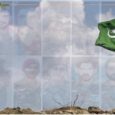
By Wara Irfan and Hawwa Fazal
Slipping through the cracks: Why thousands of Pakistanis are dying to leave the country
Despite the introduction of multiple laws, migrants continue to leave the country through illegal channels in the hope of a brighter future.
Weeks after a fishing boat, carrying up to 750 refugees, capsized off the coast of Greece, the Federal Investigation Agency (FIA) in Pakistan has gone into overdrive, announcing the arrests of dozens of ‘human smugglers’ and promising to disrupt the entire network of agents and operators involved in the illegal business.
But why has it taken so many deaths for the authorities to spring into action? Why did so many lives have to perish for the law enforcement agencies to realise this is a problem? Most importantly, why are Pakistanis willing to walk (and swim) through the valley of death to reach ‘greener pastures’?
Everybody wants to escape
The issue of migration — whether legal or otherwise — has long existed in Pakistan. Of late, however, there has been a huge uptick in people wanting to leave for better livelihoods due to a precarious, high-inflation economy, coupled with rising unemployment, as well as a coercive and unstable political climate.
“Pakistan’s economic and political conditions have deteriorated greatly,” said Hassan Zaidi, a filmmaker who has closely documented the migrants’ journey across multiple routes and borders. “It [stability] is directly proportional to legal and illegal [migrations], both of which are [currently] overloaded. The Canadian embassy doesn’t have time, European embassies don’t have time; it’s so difficult to get an appointment at the US embassy. Everyone wants to get out.”
According to the Displacement Tracking Matrix of the International Organisation for Migration, 4,065 migrants have arrived in Europe from Pakistan by land and sea this year alone. Over the last five years, 273,331 Pakistanis were deported from countries across Europe, according to the FIA.
Moving towards greener pastures
“Youngsters mostly from rural areas are motivated by seeing people in their surroundings, who after years of struggle, managed to make ‘kothis’ (bunglows),” explained Zaidi.
Almost every family in these towns has a member living abroad, he said. Most of these people managed to migrate legally in the 1960s.
These migrations were driven after the construction of Mangla dam by a British firm. The community displaced due to the project was invited to settle in the United Kingdom (UK) when 250 villages in Mirpur were flooded. Mirpur is still known as ‘mini England’.
Again in 1967, the British invited thousands of Pakistanis to settle in the UK. These Pakistanis served as textile mill workers, domestic workers and nurses addressing UK’s labour shortages in textile mills and health departments following the second World War.
Ali Nobil Ahmad, in his book Masculinity, Sexuality and Illegal Migration, posits that masculinity plays a key role in men attempting treacherous journeys despite knowing the dangers.
Adding to the argument, Zaidi said that many attempt it because of the belief that they would rather die trying to make the lives of their family better, than sit idle and do nothing.
According to the findings of the International Center for Migration Policy Development (ICMPD), young migrants also tend to ignore the warnings from tragic incidents believing them to be cases of “individual bad luck or bad decision making”. Moreover they see unemployment (long-term) as a bigger problem than the “short-term risks to their well-being on the irregular migration journey”.
This phenomenon can also be observed in the numerous videos on TikTok, in which friends of illegal immigrants can be seen cheering them despite knowing the dangers. The men attempting this journey are termed to be courageous and brave sons of their parents.
Previously, agents who used to convince young people to migrate, used to be highly reputed persons of the area coming into contact with people through word of mouth. Now with the advent of social media, TikTok and other similar social media platforms are being used by agents to market their services.
For instance, many immigrants on TikTok have made testimonials for ‘General Musa’, thanking him for helping them reach Europe.
There are numerous similar videos on the platform.
When Dawn.com asked TikTok about the videos and the platform’s actions to curtail the advertisement of illegal migration and human trafficking, TikTok’s spokesperson said that the company has strict community guidelines and are rolling out further changes to combat the platform’s misuse.
An unsuccessful legislation
In 2018, the Government of Pakistan introduced two laws to curtail the illegal movement of migrants — the Prevention of Trafficking in Persons Act and the Prevention of Smuggling of Migrants Act. The latter legislation decriminalised migrants and entailed punishment of up to 14 years in prison for the agents.
However, these laws have largely been unable to deter both the traffickers and the migrants who are desperate to get to Europe.
This legislation also isn’t new in nature. Before these laws, “there were criminal laws prohibiting these activities”, said Furkan Ali, a lawyer closely looking at the migrant crisis. “Like most things in Pakistan, I don’t think the new legislation has had any impact,” he added. “This is not a problem that stems from a lack of legislation.”
Instead, the issue arises from people’s needs, desires and motivation to have a chance at better living conditions. “You cannot stop someone’s desire to move abroad. How can we argue with [someone like] Shahida Raza who has lost her job and husband; she is failed by the economic system, failed by the justice system and failed by society. She will try to leave. We can’t stop that,” said Ali. “All you can do is stop the people who are trying to help her with that illegally and taking money for it.”
FIA Anti-Human Trafficking and Smuggling Wing Director Muhammad Alam Shinwari told Dawn.com that in the past few years, thousands of agents have been arrested for facilitating the illegal migration of people from Pakistan.
He added, however, that in most of these cases, the victims “resile from their statements”, rendering it impossible to prosecute them. The other challenge is that people now travel with valid visas to the first location, which makes it difficult to catch them. “If we ask too many questions, it becomes a human rights law violation.”
The FIA has 10 police stations across Pakistan where such cases can be registered. They have also updated and tightened the border management system. “At airports, we have started questioning people and stopping travellers who look like victims,” he said.
Similarly, Ali shared that the “FIA has been making arrests and are in touch with airlines to get information about people who’ve travelled to Libya from Pakistan […] and who is booking [tickets] for them.
Libya
Libya is a point of focus “because people who get on these boats, they go from Northern Africa because that is the shortest distance [to the tip of Italy].”
Wreckage of a shipwreck in southern Italy which left dozens of migrants dead after the boat in which they were travelling smashed onto the rocks, in Cutro, Italy. — Reuters/Remo Casilli
“Immigration staff has been given training and new equipment to deal with these issues. Our systems have been connected to NADRA and other databases. There is an intelligence task force consisting of different agencies, especially on our border points, to block people going through land and sea routes,” said Shinwari.
Only recently, the FIA registered 149 cases and arrested 41 human smugglers in connection with the latest Greece boat tragedy in which hundreds of Pakistanis lost their lives.
“FIA can’t spring into action when there is a tragedy like this,” Ali stressed, “It needs an ongoing strategy to get to the human traffickers.”
The migrants and refugee crises are not exclusively Pakistan’s problem. It is, rather, a global issue. With so many countries, transnational actors across borders involved, it becomes a complicated and complex web that is hard for any singular agency to unwind.
The routes
Several routes are used to smuggle people through Balochistan (see map). According to journalist Akbar Notezai, who has reported extensively on the subject, one route goes from Karachi via the RCD Highway towards Taftan, then onward to Zahedan (capital of the Iranian province of Sistan-Baluchistan) to the Turkish border and beyond. Another runs from Karachi to Sistan-Baluchistan via Lasbela and Kech districts. Yet another goes from Quetta towards western Balochistan to the border towns of Taftan, Mashkel or Rajay.
Taking the sea route means first travelling to Gwadar district via the Coastal Highway from Karachi, which allows people to skirt the dangerous, insurgency-hit areas further inside Makran.
After Iran erected a 15-foot high wall along its border with Afghanistan’s Nimruz province, Afghans also began to get smuggled out via Balochistan. Duk, a deserted area near the Pak-Afghan border in Chaghi, is the point where they cross over into Pakistan. From Duk, the Afghans are taken 100kms away in the direction of Naukundi along katcha roads and onward to Mashkel or Rajay, which are their gateway into Iran and onwards to Turkey and Europe.
For Pakistanis from Punjab, who seek to cross the border illegally, Quetta is the first port of call. Agents arrange for them to travel to the border, usually via bus through the western parts of the province. Kech, Gwadar and Panjgur districts in the restive Makran region towards the south were once much frequented by migrants, but no longer, because they are most likely to encounter Baloch insurgents there. And these outlaws are particularly hostile towards Punjabis.
In fact, a survey by the International Organisation for Migration (IOM) in 2021 found that 46 per cent of people trying to migrate are in the age group of 25-34 and 80 pc hail from towns of central Punjab — Mandi Bahauddin, Gujrat and Gujranwala — and 10 pc from Khyber Pakhtunkhwa (KP).
Pakistani agents are mostly only concerned with the things within the country and once they get migrants across the Pakistani border, they are handed over to agents of that respective country for the journey ahead. This also hinders the local authorities from stopping the subsequent developments as their scope of control, policing and prosecuting is limited to local boundaries.
To curb this problem, the FIA has signed multilateral and bilateral agreements with different countries to exchange information — and their offices exist in countries such as Iran, Oman, Greece, Spain and the UK. The coordination mechanism between liaison officers of different countries help them share data with each other. However, the effectiveness of these exchanges remains questionable.
On the other hand, the network of traffickers is much better organised and not just limited to illegal migration. It also deals with money laundering, narcotics and other forms of smuggling in Pakistan, providing similar routes for these acts. “These are set routes, not only for [the movement of] people but also things come and go [through them],” said Zaidi. The unregulated inflow of Iranian petrol and diesel is one such example.
Air routes are now commonly used through Iran, Libya and Dubai. The agent in Pakistan helps people get legal visit visas and tickets for the first location, after which they are sent over to the next agent in the chain. The latter would help these legal visitors get onto small boats which would eventually help them land in Europe. – Pak Destiny






